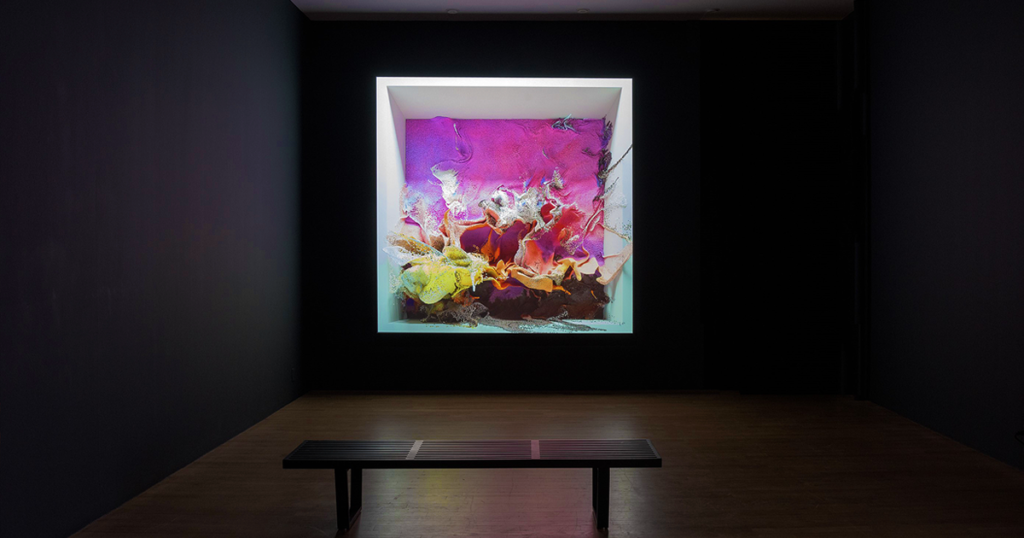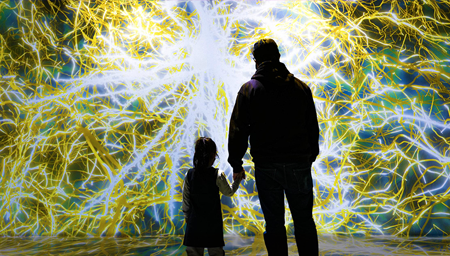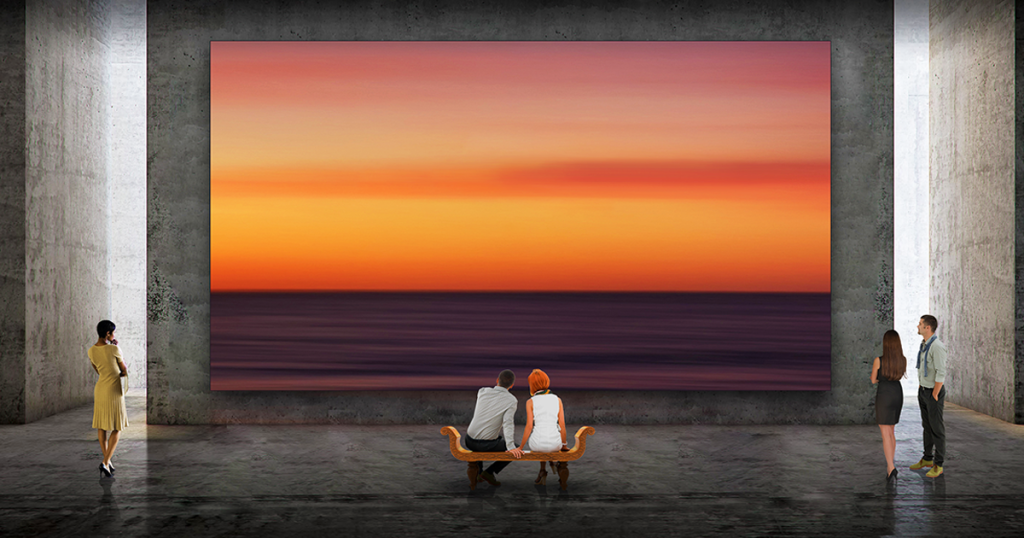video | Refik Anadol, Melting Memories
Museums and galleries have a lot to teach about the best ways to display digital canvases in home environments
by Kirsten Nelson
November 22, 2022
You know that feeling you get when you walk into a room and see a bouquet of flowers? There’s a brief moment of surprise. Those aren’t usually there! It’s a new element in your roomscape, and it brings a quiet thrill.
Maybe it’s not flowers. Maybe it’s a new book, or a new bottle of Scotch, or a new arrangement of throw pillows. Something that you added, that you love, that’s a delight to contemplate, and it wasn’t there just the day before.
Now imagine that feeling amplified spectacularly in the most refined way possible. I’m not talking about fireworks or a parade. I’m talking about something that awakens the senses while also magically blending into your home in a way that makes each moment better. It combines the novelty of seeing something new with the soothing harmony we try to cultivate in our home.
That is what it’s like to add one of these new attention-grabbing digital canvases to your home. It’s an ambiance changer. It’s a scene-setter. And it’s dynamic, capable of constantly changing, so it will always feel new.
The phrase “digital canvas” is being thrown around a bit haphazardly these days. Anything that can help display digital art or the exotic works in your NFT collection is called a canvas. But in what seems like a limited interpretation of the possibilities presented by these new speculative realms of art—some of the works being generative, constantly changing in response to data inputs, movement, and the environment surrounding them—we seem to be hung up on
Kirsten Nelson, “Your Home is Your Canvas“
(2/11/22)
a look at how emerging technology is going beyond just making homes smart to making them expressive
video | Refik Anadol, Melting Memories
Tim Sinnaeve, “Enriching the Artist’s Digital Palette“
(8/19/22)
Barco Residential’s Managing Director on how artist Akiko Yamashita’s comments in “Natural Wonder” show that the creative community is beginning to embrace the potential of digital canvases
photo | Refik Anadol, Quantum Memories (Bitforms Gallery)
rectangles. As in, we’re still hanging up the same old 16:9 panels and wondering why it feels like we’re only watching TV when in fact we’re looking at expensive works of art.
What is it about looking at fine art, anyway? Why does it create a moment of pause instead of merely lulling you into a soporific state? We probably can’t answer that question in this brief piece of writing, but we can address how fine art is typically displayed in galleries. And we can examine how we might make sure these new digital works get the same treatment as the other “static” pieces of art in our homes.
The Shape of Art to Come
To do that, first we need to get beyond the rectangle. How many oil paintings actually adhere to a 16:9 aspect ratio? And what about sculptures? Many of these new digital works have more in common with sculptures. They might be rendered in 3D, or in many cases their interactive elements make them feel more like an art installation than a print on a wall. That being the case, do we really want to lock them into the same tight frame we wrap around commercials and sports?
The makers of video technology see a future beyond the rectangle. Tim Sinnaeve, Managing Director of Barco Residential, is a passionate advocate of discovering new forms and means for displaying digital art in the home. “The whole idea of a 16:9 aspect ratio is very limiting when you’re talking about art,” he said. “And it’s a limitation that actually also negatively impacts the art world, and most importantly artistic freedom, because you get this self-fulfilling prophecy where the artist feels like they have to create their work in 16:9 because that will fit the screen it ends up on. Then on the other side, the thinking goes, ‘All the art that’s available is 16:9, so that’s why I’m using a 16:9 display or a TV.’”
If we want to get to a near future where we see more creative additions of these multi-faceted, multi-sensory works into our living spaces, we need to consider the experience you have in an art gallery. What elements help to elevate artwork? How can we ensure that a piece is displayed in a manner equivalent to its value?
The answer may vary, with options that include direct-view LED video walls or projection setups, but ultimately what we’re talking about is that suddenly ubiquitous “digital canvas.” It’s the surface that will determine whether an artwork looks like it was worth the investment.
“The canvas actually becomes part of the value, because it determines how the art looks, and how you experience it,” Sinnaeve said. “If you’re a serious collector, you need to work with professionals to make sure that the right digital canvas is selected.”
Once you’ve seen a major digital work on a proper LED screen or lighting up a wall with high-end video projection, there’s no going back. “Going from that level of depth and quality to seeing it on an 84-inch OLED TV is just night and day,” Sinnaeve said. “It’s between something that moves you and that you really would like to be a part of your life, compared to something that just doesn’t do it. And technically the work is the same.”
More than just a video technology decision, “it’s really about looking at it from an architectural and design perspective and considering where and how you want your digital canvas to create an experience,” Sinnaeve said. “The way you approach that shouldn’t be that different for digital art
Steve Haas, “Million-Dollar Wall, Hundred-Dollar Sound
(6/24/22)
Video walls have become a big status thing—and an even bigger investment—but getting them to sound good isn’t as easy as you might think

Touch displays like the ones already being used in museums will up open an unexplored world of educational and entertainment experiences for domestic settings
Sign up for our monthly newsletter
to stay up to date on Cineluxe
versus ‘traditional’ art, at least from a philosophical perspective. There are the fundamentals of displaying the work and then there are factors related to how the artist intended it to be seen as well.”
That’s where we get to the curator role that many custom residential technology integrators may soon be adding to their skillsets. Savvy installers will be able to work with artists to realize the artist’s vision while also presenting clients with a beautiful experience of digital fine art at home.
Setting the Scene
We need to also think about the environment surrounding these works. Start with the lighting. Just as you would think about properly lighting a physical work of art, work with a professional integrator who knows how to ensure your digital art is depicted in a manner befitting its merits rather than receding into the background because it just looks like a TV.
Many digital artworks also have a sonic element, and some of them are actually entirely audio-based. But even for visual-only pieces, it’s important to consider acoustics and sound as part of the experience. To get some insight into these invisible-but-essential factors, I spoke with Steve Haas, CEO and Principal Consultant with SH Acoustics.
Especially because digital art might be installed in large open spaces in homes, you should be sure there’s not a lot of cacophony created by reverberant reflections. Think about the enveloping hush of a gallery and how that adds a luxuriously contemplative level to the viewing experience. The addition of some properly designed acoustic control can help to deliver that effect at home. Also, if there is a sound component, you might want to acoustically isolate the room to prevent the creation of—or distractions from—disturbances elsewhere in the home.
You might consider using some of the high-tech directional speakers that can precisely aim where sound is traveling—the kind they’re using at compelling new immersive-experience emporiums like the Illuminarium in Atlanta and Las Vegas. These spaces go beyond the usual multi-surface video projection into full-scale aural choreography, which together will make you forget all about the outside world.
“Having rooms like that, filled with unique content that updates regularly, I could really see that happening,” Haas said. His work in museum experience design and in high-end residential media and acoustic design have combined to give Haas a unique vision for how we might reimagine our homes.
“I see having these elements that are interspersed throughout the house in a very purposeful, creative way that introduce video and soundscapes and all the other elements that make that experience fully immersive,” Haas said. “And sometimes, if it makes sense, potentially adding informative or educational content, which can also change, of course.”
Going beyond home theaters or media rooms, you might add dynamic digital artworks to corridors, atriums (direct-view LED walls are bright enough to handle high-brightness areas), foyers, great rooms, or anywhere you want to experience additional levels of engagement. In recreational spaces, there’s even more possibility, with full-scale video, sound, and lighting activations in personal nightclubs, bowling alleys, patios, pools, and more.
From there, Haas takes it one step further, returning to the idea of immersive exhibits found in museums. “Think about having custom-produced media from any of the top museum content producers,” he suggested.
“How can you create this hybrid, totally unique world in somebody’s home that might even have didactic meaning, historical content, or educational content for their kids or anyone else?” Haas asked. “Each of these thematic experiences can represent something important to the family’s lives, the same way a museum presents media or physical content that’s important to the institution’s mission.”
That might also address the “these kids today and their phones” challenge—though it’s hardly just the kids. Every generation is now compulsively interacting with screens and content on a regular basis. What if the home was similarly compelling with ever-changing atmospheric elements? Maybe then we could get more people to look up from their screens and enjoy living together.
Steve Haas’s firm, SH Acoustics, did the acoustic and audio design work for the Statue of Liberty Museum, which features the kinds of video displays and interactive technologies that could be creatively deployed in a home environment
Kirsten Nelson is a Brooklyn-based writer, speaker, event content producer, and podcast host who writes frequently for technology brands, integration firms, and experience design agencies. She was the editor of SCN magazine, and before that, co-launched Residential Systems. Kirsten is also a co-founder, editor, and writerly salon host of CreativeStack, a newsletter for the experience design community.
© 2023 Cineluxe LLC





